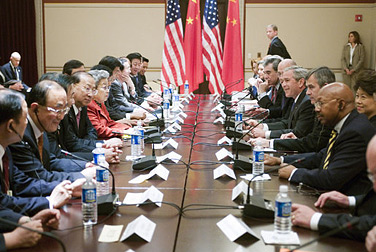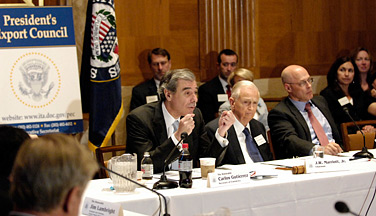|
|
|
||||||||||
|
Short Takes: News from the International Trade Administration United States and China Look for Solutions to Long-Term EconomicProblems Secretary of Commerce Carlos M. Gutierrez joined 16 other U.S. cabinet officials and agency heads, as well as 15 ministers and 11 vice ministers from the People’s Republic of China, in Washington, D.C., on May 22–23, 2007, for the second meeting of the U.S.–China Strategic Economic Dialogue (SED). The first meeting was held on December 14–15, 2006, in Beijing, China.
Although the SED framework is geared toward discussion of long-term strategic issues, some near-term results were realized during the May meeting. One such result that will benefit U.S.-China trade was an agreement to greatly increase the number of daily passenger flights between China and the United States and to provide virtually unlimited access for U.S. and Chinese cargo carriers. This civil aviation agreement will help expand bilateral commercial ties and will support the Department of Commerce’s effort to facilitate Chinese group leisure travel to the United States. During the SED, the United States and China issued a declaration to launch negotiations on an agreement to expand opportunities for U.S. travel and tourism agencies to provide services to Chinese customers. This initiative, led by the International Trade Administration, will facilitate U.S. businesses’ access to a Chinese market that is projected to grow to 100 million outbound travelers within the next 15 years. One of U.S. industry’s biggest challenges in China is the lack of transparency in rule making and administrative decision making. At the SED, Gutierrez discussed with his Chinese counterparts ways to increase transparency in China. The Commerce Department team will continue to work with China to make public notice and comment periods for rules and regulations standard practice. “We welcome China as a responsible member and an important contributor to the global economy,” remarked Gutierrez at a press conference following the SED. “We look forward to working together to achieve a level playing field for all of us.” The next meeting of the SED is scheduled to take place in Beijing in December 2007. U.S.–India Trade, Capital Investment Subjects of Recommendations from President’s Export Council The President’s Export Council approved two letters of recommendation to President George W. Bush regarding U.S.–India trade and capital markets at a meeting held in the Dirksen Senate Office Building in Washington, D.C., on June 7, 2007.
In its letter on India, the council observed that India, with a gross domestic product of $786 billion and growth rate of 8 percent, presents a “tremendous opportunity for U.S. exporters and investors.” But the council noted that significant barriers to entry remain, specifically pointing to five areas of concern: high tariffs, investment restrictions, regulatory barriers, weak enforcement of intellectual property rights, and poor infrastructure. The council urged continued engagement by the United States in bilateral initiatives. “In bilateral discussions, such as the U.S.–India Trade Policy Forum and the U.S.–India Commercial Dialogue, the administration has an opportunity to advance various policy reforms to improve the trade and investment climate [in India].” The council also applauded the recent U.S. efforts in advancing the U.S.–India civil nuclear cooperation agreement and urged further encouragement of Indian engagement in the Doha Round of multilateral trade negotiations. In its letter on capital investment, the council strongly expressed its belief that “maintaining the preeminence of U.S. capital markets is a matter of high national priority.” It voiced its support for recommendations made recently by several commissions and reports that have examined the regulation of capital markets, and it specifically urged action in six areas: maintaining an open investment climate; establishing principles of effective regulation, including careful cost-benefit analysis of proposed rules and regulations; moving expeditiously toward convergence around high-quality international standards of regulation, accounting, and auditing; reforming approaches to regulatory enforcement, securities litigation, and auditor liability; coordinating regulatory approaches among federal agencies and between federal and state regulators; and reexamining aspects of the Sarbanes-Oxley Act. The full texts of the two letters are available on the Web site of the President’s Export Council. Applications Sought for Market Development Cooperator Program Industry groups and non-profit organizations have until July 13, 2007, to submit applications for participation in the Commerce Department’s Market Development Cooperator Program (MDCP). The program provides financial and technical assistance from the International Trade Administration (ITA) to support projects that enhance the global competitiveness of U.S. manufacturing and services industries. An MDCP award establishes a partnership between ITA and non-profit industry groups, such as trade associations or chambers of commerce. Those groups are particularly effective in reaching small and medium-sized enterprises. Participating groups pledge to pay a minimum of two-thirds of the project cost and to sustain the project after the MDCP award period ends. There is an individual award limit of $175,000. Funds may be expended over the period required to complete a project, but the period cannot exceed three years without an extension. MDCP award recipients pursue a variety of approaches to improving U.S. competitiveness. For example, one recipient, the Advanced Television Systems Committee (ATSC) Forum, worked closely with ITA staff members and experts from the Federal Communication Commission to help educate Latin American governments about the benefits of the ATSC high-definition television (HDTV) standard, which is used, and primarily was developed, in the United States. Within days of Mexico’s adoption of the ATSC standard, U.S. firms were signing multimillion dollar sales contracts for HDTV transmission and processing equipment. Another recipient, the Hosiery Technology Center (HTC), uses quality testing, technological innovation, and joint sales efforts to help U.S. hosiery manufacturers. Leveraging its award, with assistance from ITA staff specialists, the HTC has helped several U.S. firms sell millions of dollars worth of hosiery to previously unexploited markets, such as Japan. On average, $100 in exports result from every $1 of federal award money. The MDCP was established by the Omnibus Trade and Competitiveness Act of 1988 as a unique way to “develop, maintain, and expand foreign markets for nonagricultural U.S. goods and services.” ITA has funded 84 projects since the first awards were made in 1993. For more information on the MDCP, and to obtain an application kit for the 2007 competition, go to www.trade.gov/mdcp/.
|
|

